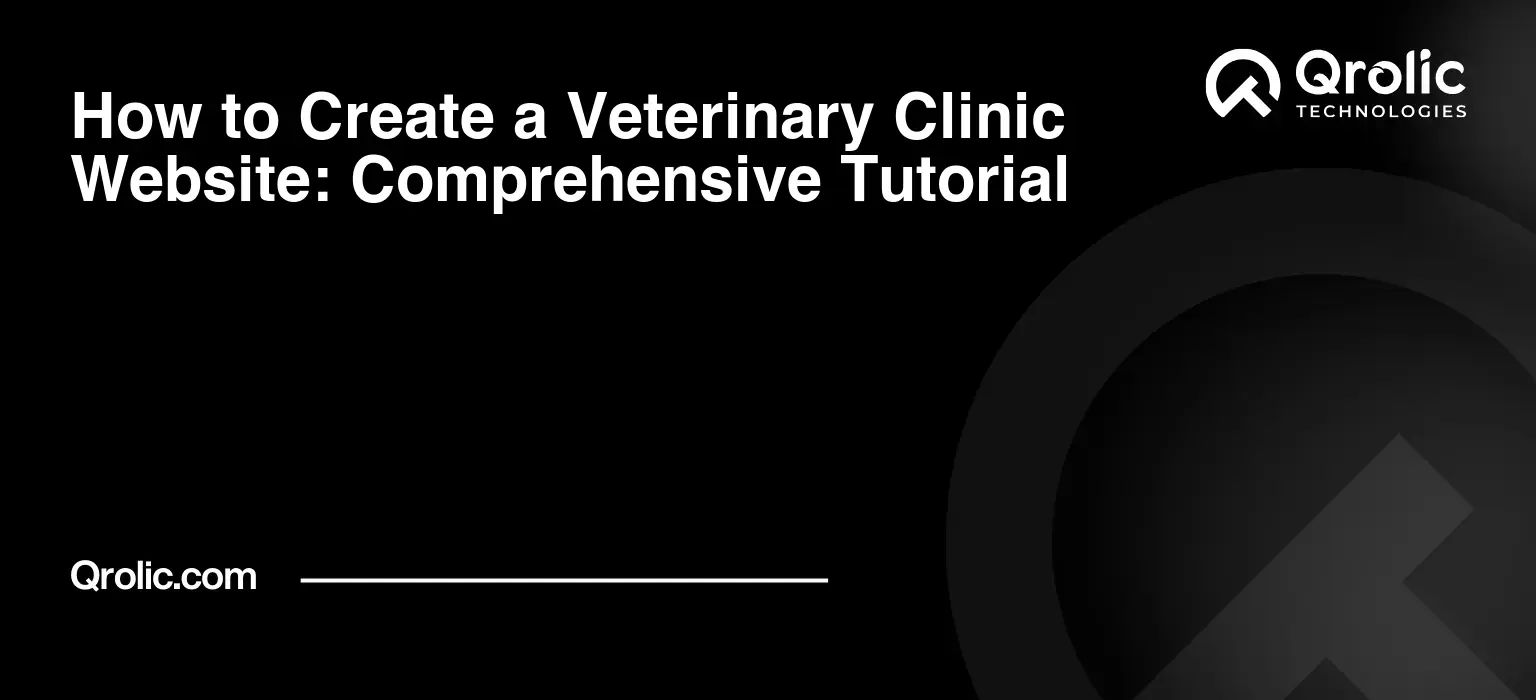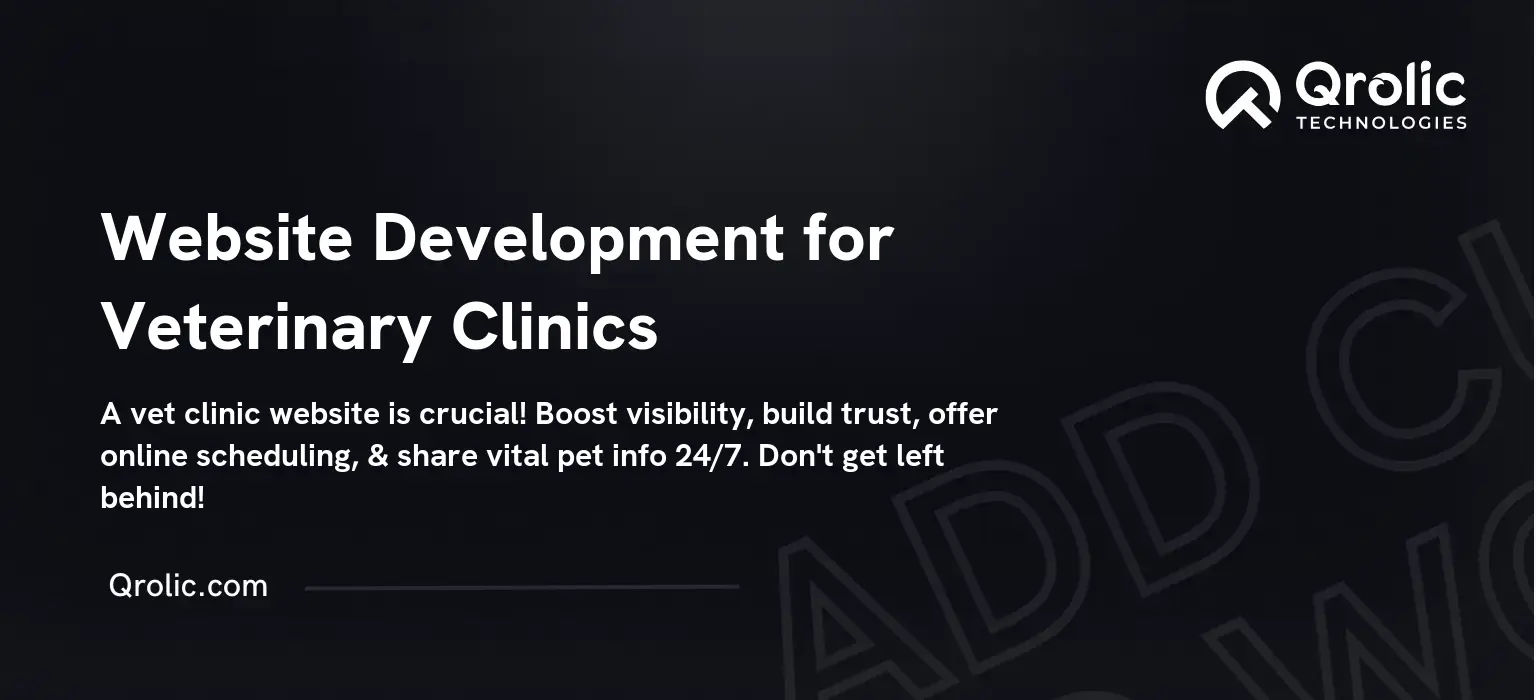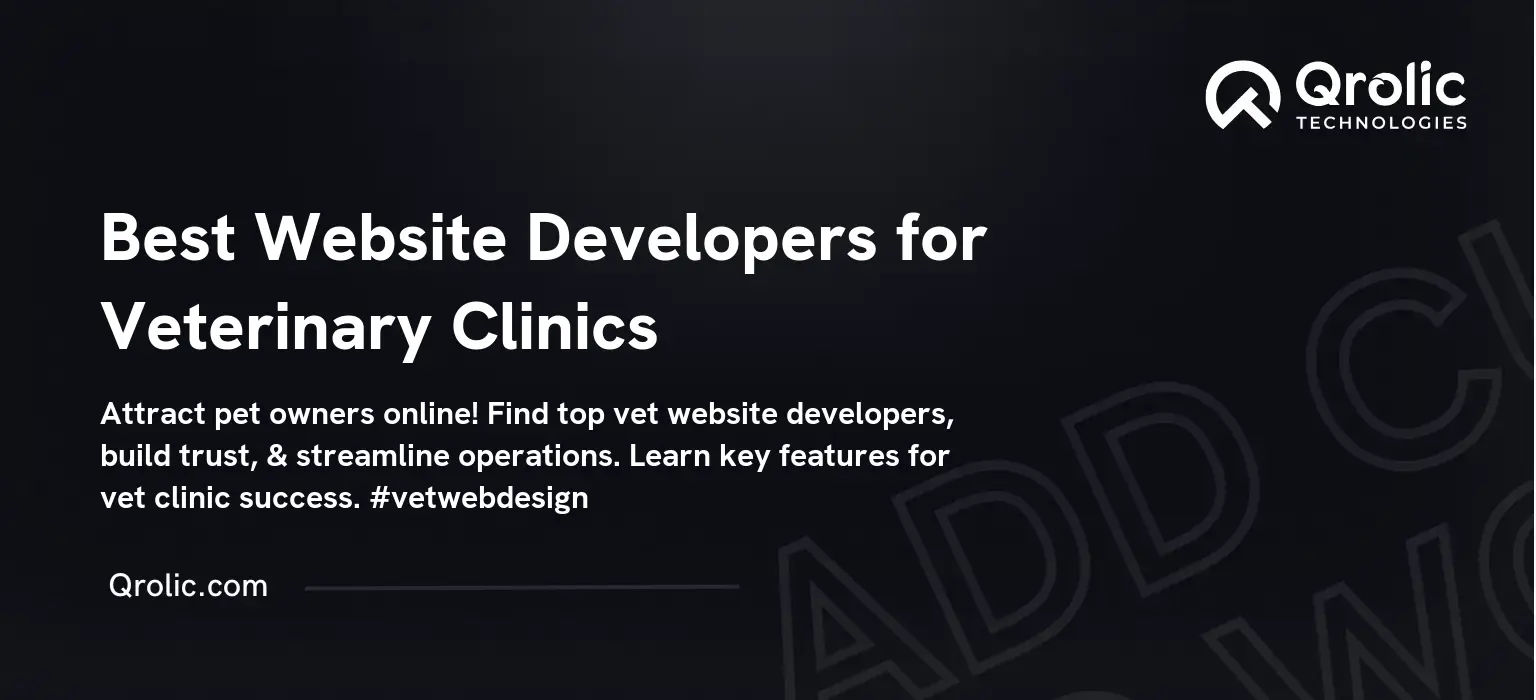Quick Summary:
- A clinic website builds trust and attracts new clients.
- Plan content, choose a platform, and build carefully.
- Optimize for search, promote, and maintain regularly.
Table of Contents
- Why Your Veterinary Clinic Needs a Website (Now More Than Ever)
- Establishing Trust and Credibility: Being Seen as the Go-To Expert
- Attracting New Clients: Expanding Your Reach Beyond Your Neighborhood
- Providing Convenience and Information: Meeting Client Needs Online
- Standing Out from the Competition: Highlighting Your Unique Value Proposition
- Planning Your Veterinary Website: Laying the Foundation for Success
- Defining Your Target Audience: Who Are You Trying to Reach?
- Setting Goals and Objectives: What Do You Want to Achieve?
- Content Planning: Creating Valuable and Engaging Information
- Choosing a Domain Name: Your Online Address
- Selecting a Web Hosting Provider: Where Your Website Lives
- Building Your Veterinary Website: Bringing Your Vision to Life
- Option 1: DIY Website Builders (Easy and Affordable)
- Option 2: WordPress (Powerful and Customizable)
- Option 3: Hiring a Web Design Agency (Professional and Hands-Off)
- Step-by-Step Guide to Building a WordPress Website
- SEO for Veterinary Websites: Getting Found Online
- Keyword Research: Understanding What Pet Owners Are Searching For
- On-Page Optimization: Optimizing Your Website’s Content and Structure
- Off-Page Optimization: Building Authority and Reputation
- Technical SEO: Ensuring Your Website is Crawlable and Indexable
- Promoting Your Veterinary Website: Driving Traffic and Engagement
- Social Media Marketing: Connecting with Pet Owners Online
- Email Marketing: Nurturing Relationships with Clients
- Content Marketing: Providing Valuable Information to Pet Owners
- Paid Advertising: Reaching a Wider Audience
- Maintaining Your Veterinary Website: Keeping It Fresh and Effective
- Regular Content Updates: Keeping Information Current
- Security Updates: Protecting Your Website from Threats
- Performance Monitoring: Ensuring Optimal Speed and Functionality
- Qrolic Technologies and Your Veterinary Website
- Conclusion: Creating a Thriving Online Presence for Your Veterinary Clinic
Why Your Veterinary Clinic Needs a Website (Now More Than Ever)
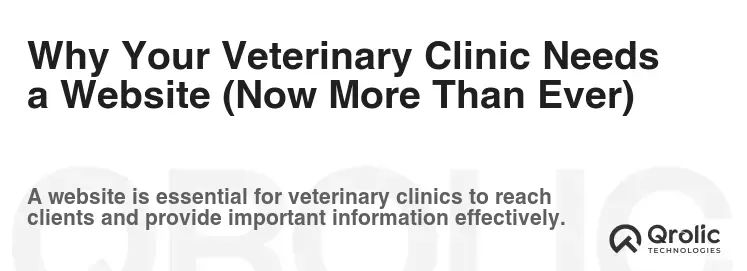
In today’s digital age, a robust online presence is no longer optional; it’s a necessity, especially for veterinary clinics. Think of your website as your 24/7 virtual receptionist, tirelessly working to attract new clients and provide valuable information to existing ones. It’s about building trust, establishing your expertise, and making pet owners’ lives easier. Let’s explore the ‘why’ behind a veterinary website.
Establishing Trust and Credibility: Being Seen as the Go-To Expert
- Showcasing Expertise: Your website allows you to highlight your veterinarians’ qualifications, specialties (e.g., surgery, dentistry, dermatology), and years of experience. Detailed bios with photos immediately build a personal connection. Sharing case studies (while maintaining patient confidentiality!) demonstrates your problem-solving abilities and successful outcomes.
- Client Testimonials and Reviews: Positive reviews are digital gold. Actively solicit testimonials from happy clients and prominently display them on your website. Encourage clients to leave reviews on platforms like Google My Business and Yelp, and link to those profiles from your site. Address any negative reviews constructively and publicly to show you value client feedback.
- Professional Design: A visually appealing, user-friendly website communicates professionalism. A poorly designed website can deter potential clients, making them question your competence. Invest in a clean, modern design that reflects the quality of care you provide.
Attracting New Clients: Expanding Your Reach Beyond Your Neighborhood
- Search Engine Optimization (SEO): When a pet owner searches “veterinarian near me” or “dog vaccinations [your city],” your website needs to appear at the top of the search results. SEO involves optimizing your website’s content, structure, and technical aspects to rank higher in search engine results pages (SERPs). We’ll delve into SEO strategies later in this tutorial.
- Local SEO: Focus on local SEO strategies to attract clients in your immediate area. Claim and optimize your Google My Business listing, ensuring your business name, address, phone number (NAP), and hours are accurate. Encourage local citations (mentions of your business on other websites).
- Targeted Advertising: Use online advertising platforms like Google Ads and social media ads to target pet owners in your service area. Create ads that highlight your unique selling propositions (e.g., specialized services, compassionate care, convenient hours).
Providing Convenience and Information: Meeting Client Needs Online
- Online Appointment Scheduling: Make it easy for clients to book appointments online, reducing phone calls and freeing up your staff’s time. Integrate a scheduling system that allows clients to see available time slots and select the most convenient option.
- Online Pharmacy and Refills: Offer an online pharmacy for convenient medication refills. This provides a valuable service to your clients and generates additional revenue for your clinic. Ensure your online pharmacy is compliant with all relevant regulations.
- Pet Care Resources: Provide valuable information about pet health, nutrition, behavior, and common conditions. Create blog posts, articles, and downloadable guides that address pet owners’ frequently asked questions. This positions you as a trusted source of information and strengthens client relationships.
- FAQs and Contact Information: Clearly display your clinic’s address, phone number, email address, and hours of operation. Create a frequently asked questions (FAQ) section to address common inquiries and reduce the number of phone calls your staff receives.
Standing Out from the Competition: Highlighting Your Unique Value Proposition
- Showcase Unique Services: If you offer specialized services (e.g., laser therapy, acupuncture, exotic animal care), highlight them prominently on your website. Explain the benefits of these services and how they can improve pet health.
- Highlight Compassionate Care: Emphasize your commitment to providing compassionate care. Use photos and videos that showcase your team’s love for animals. Share stories of successful treatments and heartwarming client experiences.
- Build a Brand Story: Tell the story of your clinic – its history, values, and mission. This helps clients connect with you on a personal level and differentiate you from the competition.
Planning Your Veterinary Website: Laying the Foundation for Success

Before diving into the technical aspects of website creation, careful planning is crucial. Think of this as designing the blueprint for your online presence. A well-planned website will be more effective in achieving your goals.
Defining Your Target Audience: Who Are You Trying to Reach?
- Demographics: Consider the demographics of pet owners in your service area. Are they primarily young professionals, families, or retirees? Understanding their age, income, and lifestyle will help you tailor your website’s content and design.
- Pet Types: Do you specialize in treating dogs, cats, or other animals? Clearly identify the types of pets you care for on your website.
- Pain Points: What are the common concerns and questions of pet owners in your area? Address these pain points directly on your website by providing helpful information and solutions.
- Desired Actions: What do you want visitors to do on your website? Do you want them to book an appointment, request a refill, or contact you with questions? Design your website to encourage these desired actions.
Setting Goals and Objectives: What Do You Want to Achieve?
- Increase New Clients: A primary goal for most veterinary websites is to attract new clients. Track the number of new clients who find your clinic through your website.
- Improve Client Retention: Use your website to strengthen relationships with existing clients and encourage them to return for future care. Offer online appointment scheduling, medication refills, and pet care resources.
- Enhance Brand Awareness: Increase brand awareness by showcasing your clinic’s expertise and values on your website.
- Reduce Phone Calls: Provide comprehensive information on your website to reduce the number of phone calls your staff receives. Create an FAQ section and offer online appointment scheduling.
Content Planning: Creating Valuable and Engaging Information
- Core Pages: Plan the core pages of your website, including:
- Homepage: The first impression. Clearly communicate your clinic’s value proposition and encourage visitors to explore further.
- About Us: Tell your clinic’s story, introduce your veterinarians, and showcase your team’s values.
- Services: List all the services you offer, with detailed descriptions of each.
- Meet the Team: Provide bios and photos of your veterinarians and staff.
- Testimonials: Showcase positive client reviews.
- Contact Us: Display your address, phone number, email address, and hours of operation.
- Blog: Create blog posts about pet health, nutrition, behavior, and other relevant topics.
- Keyword Research: Identify the keywords that pet owners are using to search for veterinary services in your area. Use these keywords throughout your website’s content to improve your search engine rankings. Tools like Google Keyword Planner, SEMrush, and Ahrefs can help you with keyword research.
- Content Outline: Create an outline for each page of your website, including headings, subheadings, and bullet points. This will help you stay organized and ensure that you cover all the important information.
- Visual Content: Plan to include high-quality photos and videos on your website. Use images of your clinic, your team, and happy pets. Videos can be used to showcase your services, provide pet care tips, or share client testimonials.
Choosing a Domain Name: Your Online Address
- Relevance: Choose a domain name that is relevant to your veterinary clinic and easy to remember.
- Availability: Check to see if the domain name is available before registering it.
- Brandability: Choose a domain name that is brandable and reflects your clinic’s identity.
- Extension: Consider using a .com, .net, or .org extension. For local businesses, a country-specific extension (e.g., .ca for Canada, .uk for the United Kingdom) can be beneficial.
Selecting a Web Hosting Provider: Where Your Website Lives
- Reliability: Choose a web hosting provider that offers reliable uptime and fast loading speeds.
- Scalability: Ensure that the hosting provider can scale your website’s resources as your business grows.
- Security: Choose a hosting provider that offers robust security features to protect your website from hackers and malware.
- Support: Choose a hosting provider that offers excellent customer support.
- Options: Popular providers include Bluehost, SiteGround, HostGator, and AWS.
Building Your Veterinary Website: Bringing Your Vision to Life

Now that you have a plan in place, it’s time to start building your website. There are several options available, each with its own advantages and disadvantages.
Option 1: DIY Website Builders (Easy and Affordable)
- Platforms: Squarespace, Wix, Weebly, GoDaddy Website Builder.
- Pros:
- Easy to use, even for beginners.
- Affordable, with various pricing plans available.
- Offer pre-designed templates that can be customized to match your brand.
- Provide drag-and-drop interfaces for easy content creation.
- Handle technical aspects like hosting and security.
- Cons:
- Limited customization options compared to other platforms.
- Can be difficult to migrate your website to another platform in the future.
- May not be ideal for complex websites with advanced features.
- When to Use: Ideal for veterinary clinics with limited budgets and technical expertise who need a simple, professional-looking website quickly.
Option 2: WordPress (Powerful and Customizable)
- Platform: WordPress.org (self-hosted).
- Pros:
- Highly customizable, with thousands of themes and plugins available.
- Offers greater control over your website’s design and functionality.
- SEO-friendly, with plugins available to optimize your content for search engines.
- Scalable, making it suitable for growing businesses.
- Large community of users and developers for support.
- Cons:
- Requires more technical knowledge than website builders.
- You are responsible for managing your own hosting, security, and updates.
- Can be more expensive than website builders, especially if you hire a developer to customize your site.
- When to Use: Ideal for veterinary clinics that need a highly customizable website with advanced features and are willing to invest more time and resources.
Option 3: Hiring a Web Design Agency (Professional and Hands-Off)
- Pros:
- Professional design and development.
- Customized website tailored to your specific needs.
- Hands-off approach, allowing you to focus on running your clinic.
- Expertise in SEO, marketing, and website maintenance.
- Cons:
- Most expensive option.
- Requires careful selection of a reputable agency.
- May require more time for communication and feedback.
- When to Use: Ideal for veterinary clinics that have a significant budget and want a professionally designed and managed website without having to worry about the technical details.
Step-by-Step Guide to Building a WordPress Website
Since WordPress offers the most flexibility and control, let’s walk through a basic setup:
- Choose a Web Hosting Provider: Select a hosting plan that suits your needs. Many providers offer one-click WordPress installation.
- Install WordPress: Follow your hosting provider’s instructions to install WordPress.
- Choose a Theme: Select a theme that is visually appealing and relevant to the veterinary industry. Consider themes specifically designed for medical or veterinary practices. Look for responsive themes that are mobile-friendly. Popular options include themes from ThemeForest or Astra.
- Install Essential Plugins: Install plugins to add functionality to your website. Some essential plugins include:
- Yoast SEO: For optimizing your website for search engines.
- Contact Form 7: For creating contact forms.
- Akismet Anti-Spam: For preventing spam comments.
- Elementor or Beaver Builder: For drag-and-drop page building (optional).
- A security plugin: Such as Wordfence or Sucuri
- Appointment scheduling plugin: Bookly or Simply Schedule Appointments.
- Create Your Pages: Create the core pages of your website (Homepage, About Us, Services, Meet the Team, Testimonials, Contact Us, Blog).
- Add Content: Write engaging and informative content for each page. Use keywords strategically throughout your content.
- Optimize Images: Optimize images for web use by compressing them and adding alt text. This will improve your website’s loading speed and SEO.
- Test Your Website: Test your website thoroughly on different devices and browsers to ensure that it is working properly.
- Launch Your Website: Once you are satisfied with your website, launch it to the public.
SEO for Veterinary Websites: Getting Found Online
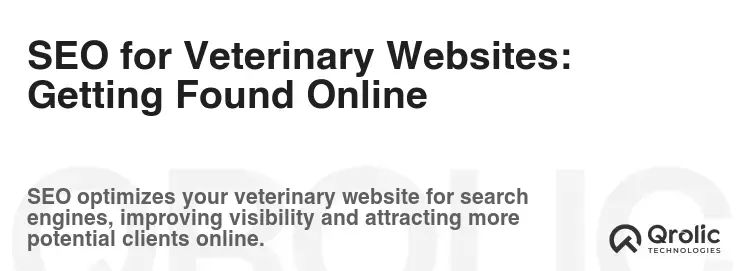
Search Engine Optimization (SEO) is critical for attracting new clients to your veterinary website. It involves optimizing your website to rank higher in search engine results pages (SERPs).
Keyword Research: Understanding What Pet Owners Are Searching For
- Identify Relevant Keywords: Use keyword research tools like Google Keyword Planner, SEMrush, and Ahrefs to identify the keywords that pet owners are using to search for veterinary services in your area. Focus on both broad keywords (e.g., “veterinarian”) and long-tail keywords (e.g., “affordable dog vaccinations near me”).
- Analyze Competitors’ Keywords: Analyze your competitors’ websites to see what keywords they are targeting.
- Create a Keyword List: Create a list of relevant keywords and organize them by topic.
On-Page Optimization: Optimizing Your Website’s Content and Structure
- Title Tags: Optimize your title tags by including relevant keywords and your clinic’s name. Title tags are the titles that appear in search engine results pages.
- Meta Descriptions: Write compelling meta descriptions that accurately describe the content of each page. Meta descriptions are the short snippets of text that appear below the title tags in search engine results pages.
- Header Tags (H1-H6): Use header tags to structure your content and highlight important keywords. Use only one H1 tag per page and use H2-H6 tags to break up your content into smaller sections.
- Content Optimization: Write high-quality, informative content that is relevant to your target audience. Use keywords naturally throughout your content.
- Image Optimization: Optimize images by compressing them, adding alt text, and using descriptive file names.
- Internal Linking: Link to other relevant pages on your website to improve navigation and SEO.
- Mobile-Friendliness: Ensure that your website is mobile-friendly, as Google prioritizes mobile-first indexing.
Off-Page Optimization: Building Authority and Reputation
- Link Building: Build high-quality backlinks from other websites to improve your website’s authority. This can be done by creating valuable content, guest blogging, and participating in industry directories.
- Local Citations: Get your clinic listed in local directories and online business listings. Ensure that your business name, address, and phone number (NAP) are consistent across all listings.
- Social Media Marketing: Promote your website and content on social media to increase brand awareness and drive traffic.
- Online Reviews: Encourage clients to leave reviews on Google My Business, Yelp, and other review platforms.
Technical SEO: Ensuring Your Website is Crawlable and Indexable
- Website Speed: Optimize your website’s loading speed to improve user experience and SEO. Use a content delivery network (CDN), compress images, and minimize HTTP requests.
- Mobile-Friendliness: Ensure that your website is mobile-friendly and responsive.
- Sitemap: Create a sitemap and submit it to Google Search Console to help Google crawl and index your website.
- Robots.txt: Use a robots.txt file to prevent search engines from crawling certain pages on your website.
- SSL Certificate: Install an SSL certificate to secure your website and protect your visitors’ data.
Promoting Your Veterinary Website: Driving Traffic and Engagement

Once your website is live, you need to promote it to drive traffic and engagement.
Social Media Marketing: Connecting with Pet Owners Online
- Choose the Right Platforms: Focus on the social media platforms that are most popular with your target audience. Facebook and Instagram are good options for most veterinary clinics.
- Create Engaging Content: Share engaging content that is relevant to pet owners, such as pet care tips, heartwarming stories, and photos of adorable animals.
- Run Contests and Giveaways: Run contests and giveaways to attract new followers and increase engagement.
- Interact with Your Followers: Respond to comments and questions promptly and professionally.
- Use Paid Advertising: Use paid advertising to reach a wider audience and target specific demographics.
Email Marketing: Nurturing Relationships with Clients
- Build an Email List: Collect email addresses from your website visitors and clients.
- Send Regular Newsletters: Send regular newsletters with pet care tips, clinic updates, and special offers.
- Segment Your Email List: Segment your email list based on pet type, service preferences, and other factors to send more targeted emails.
- Automate Your Email Marketing: Use email marketing automation tools to send automated emails based on specific triggers, such as new client sign-ups or appointment reminders.
Content Marketing: Providing Valuable Information to Pet Owners
- Create a Blog: Create a blog and publish regular articles about pet health, nutrition, behavior, and other relevant topics.
- Create Ebooks and Guides: Create ebooks and guides that provide in-depth information about specific pet care topics.
- Create Infographics: Create infographics that present data and information in a visually appealing way.
- Create Videos: Create videos that showcase your services, provide pet care tips, or share client testimonials.
Paid Advertising: Reaching a Wider Audience
- Google Ads: Use Google Ads to target pet owners who are searching for veterinary services in your area.
- Social Media Ads: Use social media ads to reach a wider audience and target specific demographics.
- Retargeting: Use retargeting to show ads to people who have visited your website but have not yet become clients.
Maintaining Your Veterinary Website: Keeping It Fresh and Effective
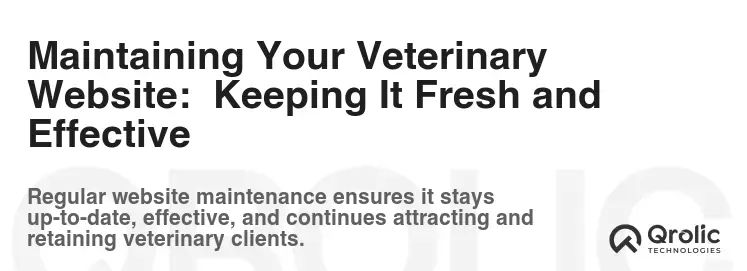
Website maintenance is crucial for ensuring that your website remains effective and up-to-date.
Regular Content Updates: Keeping Information Current
- Update Your Blog Regularly: Publish new blog posts on a regular basis to keep your content fresh and engaging.
- Update Your Service Pages: Review and update your service pages to ensure that they are accurate and reflect your current offerings.
- Update Your Team Bios: Keep your team bios up-to-date with current information and photos.
Security Updates: Protecting Your Website from Threats
- Keep Your Software Up-to-Date: Keep your WordPress core, themes, and plugins up-to-date to protect your website from security vulnerabilities.
- Use a Strong Password: Use a strong password for your WordPress admin account.
- Install a Security Plugin: Install a security plugin to protect your website from hackers and malware.
- Regular Backups: Back up your website regularly to protect your data in case of a security breach.
Performance Monitoring: Ensuring Optimal Speed and Functionality
- Monitor Your Website’s Speed: Use tools like Google PageSpeed Insights to monitor your website’s speed and identify areas for improvement.
- Monitor Your Website’s Uptime: Use uptime monitoring services to ensure that your website is available to visitors.
- Monitor Your Website’s Traffic: Use Google Analytics to monitor your website’s traffic and track your marketing efforts.
Qrolic Technologies and Your Veterinary Website
Qrolic Technologies (https://qrolic.com/) offers a range of services that can be invaluable for your veterinary clinic’s website. Consider their expertise in:
- Custom Web Development: If you require a highly bespoke website with specific features, Qrolic can develop a custom solution tailored to your exact needs.
- SEO Services: Boost your online visibility and attract more clients with Qrolic’s SEO expertise. They can perform keyword research, optimize your website content, and build high-quality backlinks.
- Digital Marketing: Enhance your online presence through social media marketing, email campaigns, and paid advertising, all managed by Qrolic’s experienced team.
- Website Maintenance: Ensure your website is always secure, up-to-date, and performing optimally with Qrolic’s maintenance services. This frees you to focus on your patients.
By partnering with Qrolic Technologies, you can ensure your veterinary website is not only functional and aesthetically pleasing but also a powerful tool for attracting new clients and growing your practice.
Conclusion: Creating a Thriving Online Presence for Your Veterinary Clinic
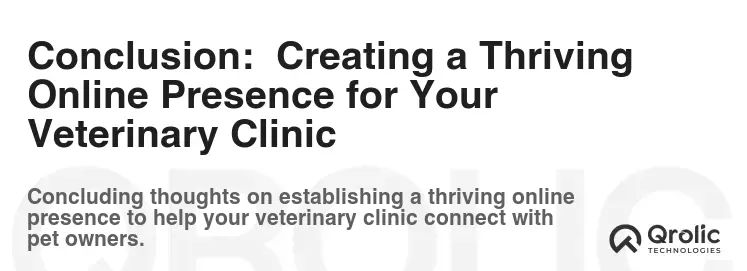
Creating a successful veterinary website requires careful planning, execution, and ongoing maintenance. By following the steps outlined in this comprehensive tutorial, you can build a website that attracts new clients, strengthens relationships with existing ones, and enhances your clinic’s brand. Remember to focus on providing valuable information, optimizing your website for search engines, and promoting your website through various marketing channels. And don’t hesitate to seek professional help when needed to ensure that your website is a valuable asset for your veterinary clinic.
